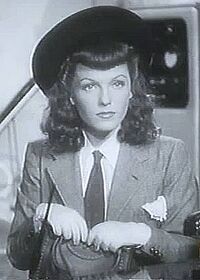Nina Campo
Nina Campo | |
|---|---|
 | |
| Born | Anastasia Nina von Herzfeld 1 February 1912 |
| Died | 27 January 1998 (aged 85) |
| Nationality | |
| Occupation |
|
| Years active | 1932–1942 |
| Spouse(s) | Vilmos Vencel |
Anastasia Nina von Herzfeld (Gylic transcription: Anastasia Nina Fonherţyfelyd; 1 February 1912 – 27 January 1998), better known by her stage name Nina Campo (Gylic transcription: Nina Kampo), was a Megelanese–Gylian actress and model. She attained great popularity in the later period of telefoni bianchi films, but her film career was cut short by Alscia's dissolution.
Early life
Anastasia Nina von Herzfeld was born on 1 February 1912 in northern Megelan, near the border with Delkora. She was of part-Acrean descent, as reflected in her name. Her parents were academics who studied Hellene mythology, and named her after the Hellene word for "resurrection".
When the Warlord Era began, the family fled to Delkora, and later moved to Alscia. She attended the Imperial University of Senik, earning a degree in history.
Career
Alscia
She began working as a model in adolescence to earn extra money, and made her film debut in 1932. Her first agent recommended that she choose an Italian stage name, since her real name made agents assume she was wholly German. She used her middle name "Nina" because it was shorter, and simply translated part of her surname "Herzfeld" ("heart-field") to get "Campo".
Her breakthrough role came with the 1933 film Ma non è una cosa seria ("But it's nothing serious"). She quickly rose to become a popular telefoni bianchi star, appearing in hit comedies like Darò un milione (1935), Una donna tra due mondi (1936), I grandi magazzini (1937), La casa della vergogna (1938), and Una storia d'amore (1939).
Nina's acting style, while aspiring to the elegance of Doris Duranti, came to be known for its brash and whimsical qualities. She embraced Alscia's androgyny chic, becoming famous for wearing masculine, often pinstriped, suits on screen. She joked that her agent's advice usually aimed to "toughen" her on screen: dye her hair black and cut it into bangs, wear hats, and refine her sharp, high-pitched tone of voice.
Her trademark as an actress was the contrast between the roles she played — donna con la D maiuscola ("lady with a capital L") — and her fast-talking, sharp-tongued, tomboyish qualities. She later speculated that if her career had continued, she would've aimed to be the Brynhild Svendsen of Alscia.
Free Territories and Gylias
Nina found herself at loose ends after Alscia joined the Free Territories in 1939. Her career faltered during the Alscian film industry's transitional period. Discouraged with the difficulty of finding work and the quality of roles on offer, she retired from acting in 1942.
She instead launched an eclectic business career. Among her occupations were: agent for her husband, illustrator Vilmos Vencel, partner in a maternity dress store, founder of a hat store, and dressmaker — the latter an occupation she learned from her mother.
Private life
Nina married illustrator Vilmos Vencel on 22 January 1942. By coincidence, the two had attended the same secondary school, years apart. The marriage lasted until his death, and they had two daughters: Camilla (b. 1944) and Dora (b. 1957).
The couple's partnership was significant to their success. Nina was six years older and had greater experience in the entertainment industry. She worked as Vilmos' unofficial agent, handling the business side of his career, and was the first to see his cartoons and provide feedback. Vilmos joked, "She slaps me if I write anything out of line; I know a cartoon's good to publish when she doesn't. I have an oddly soft face and she has oddly strong palms, so getting to a good cartoon will leave some pink handprints on my cheeks."
Camilla later commented that Vilmos was a "terrible businessman" and Nina "wished that he was more aggressive in his pursuit of fame and fortune". Apart from this, "they got along well together."
Following Vilmos' death in 1987, Nina and her daughters moved out of their home in Şarel, which became a museum to his career. Nina settled in Riáona, and worked with her daughters to publicise Vilmos' posthumous profile to match the impact of his art.
Death
She died on 27 January 1998 in her Riáona apartment of natural causes, aged 85.
